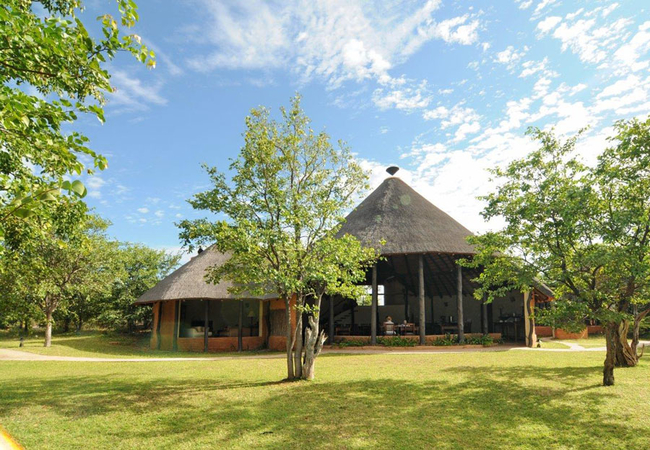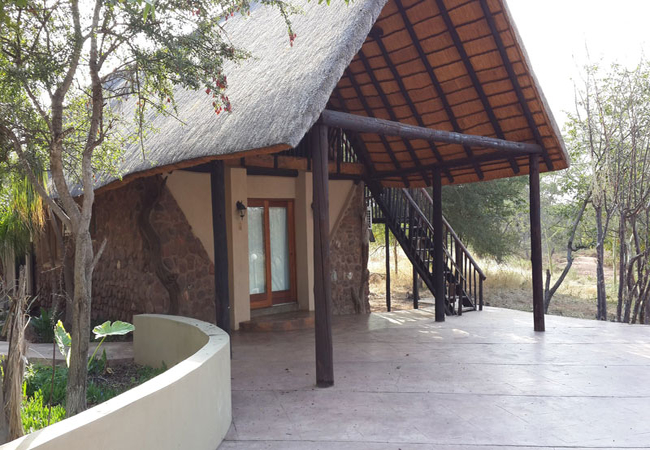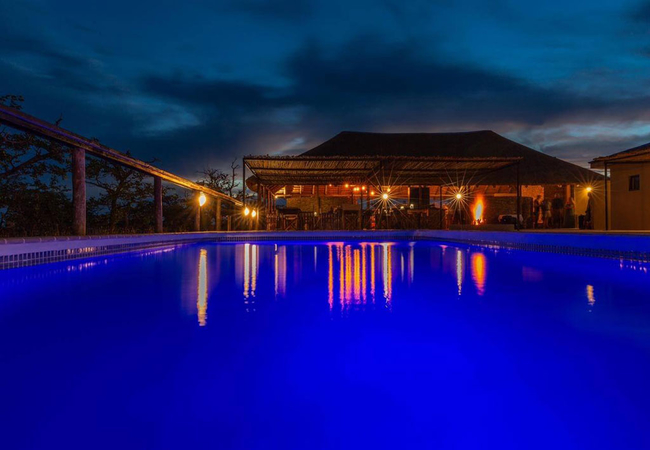About Mapungubwe National Park
Set right up against the northern border of South Africa, uniting Botswana and Zimbabwe, lies Mapungubwe National Park - an extensive savannah landscape situated at the meeting place of the Limpopo and Shashe rivers. This is the land of sandstone formations, mopane woodlands, brooding baobabs, ancient floodplains and unique riverine forests that form a dramatic backcloth for the wealth of animal life - elephant, giraffe, buffalo, white rhino, gemsbok and other antelope, extensive bir life, and the more elusive mammal like hyenas, leopards and lions.
Did you know? In the 13th century Mapungubwe was considered the most important inland settlement in the African subcontinent. It ended as a result of climatic change with a decrease in rainfall that could no longer sustain the population's traditional farming methods.
Mapungubwe is South Africa's first kingdom, a highly complex society that marked the heart of a pre-Shona kingdom between 1050 AD and 1270 AD, only to be abandoned in the 14th century. The Mapungubwe Cultural Landscape - the virtually untouched remains of the palace sites, the settlement area dependent upon them, and two capital sites that remain - was declared a UNESCO World Heritage Site in 2003 and forms part of the Mapungubwe National Park.
The Cultural Landscape provides visitors with a unique portrait of the social and political structures of a society that traded with China and India, was regarded as the most complex society in southern Africa and was the first society since the Bushmen to settle in South Africa. The kingdom was regarded as the forerunner of the Zimbabwe civilisation and at its height, Mapungubwe, which means place of the stone of wisdom, was the largest kingdom in the African sub-continent. Some 5000 people appeared to live around Mapungubwe Hill where their ‘sacred' leader lived in seclusion from his people.
After the collapse of Mapungubwe's society, it was forgotten until the wealth of artefacts on top of Mapungubwe Hill - a sandstone oval-shaped hill with sheer vertical cliffs and a plateau of about 300 metres known as the ‘place of jackals', accessible only by means of two very steep and narrow paths - were discovered.
Mapungubwe opened to the public in September 2004. Not only does it provide the public with an awesome window on the rich and varied animal life in this part of South Africa, but it is a chance to explore Mapungubwe Mountain and the culture that, despite being discovered in 1932, was kept largely hidden from the public until recently.
This discovery included three findings of significance: a beautiful golden rhinoceros made from gold foil nailed around a wooden interior, and a gold sceptre and bowl, all uncovered from the excavation of twenty three graves on the hilltop site and which are on display at the Mapungubwe Museum at the University of Pretoria.
The Golden Rhino
The rhino is thought to symbolise power because of its ferocious temperament and is still a leadership symbol among the Shona of Zimbabwe today. The little golden rhino is not only evidence of these peoples' metalworking skills and trade with the East - the rhino has a single horn like the Asian variety - but it also symbolises to the world that South Africa's cultural heritage is far richer and goes back further than realised.
But the highlight of anyone's visit to this incredible part of the world is the beauty of the area - huge boulders, rocky koppies, sheer cliff faces, wild fig trees that cling to rock faces and huge indigenous trees that stand tall amidst grassland. Mapungubwe is simply stunning. Together with the Tuli Block in Botswana and the Tuli Safari area in Zimbabwe, the Mapungubwe National Park, which covers some 28 000 hectares in its own right, forms part of the ambitious Limpopo / Shashe Transfrontier Park - a joining of nations in the provision of an unlimited area in which animals can freely wander.
Need to Know
WhereMapungubwe National Park, Soutpansberg, Limpopo, South Africa
WhenDaylight hours.
OvernightStay in Musina Accommodation, Limpopo
Disclaimer
Please note, business details can change. While we endeavour to ensure all information provided by the service provider is correct at the time of publication, we do not assume any liability caused by errors or changes, such as price, cost, time, and location. Please check with the provider that the activity/business is still offered as described, before making any travel plans.
Feedback?
If this is your reserve, you can let us know if anything on this page is outdated or contains inaccuracies, by email. We regret, we do not have any other information, please contact the provider if you have questions.
Additional Reading
You might also be interested inGame & Nature Reserves in Limpopo
In the vicinity
Hotels & other accommodation options in Musina

Mopane Bush Lodge
Mopane Bush Lodge is a small bush retreat, graded a 4-Star luxury lodge, of African Renaissance design. Nestling in the Mopane bushveld, it is at...

African Extreme Safari
The Lodge comprises private accommodation in a number of comfortable rooms. All rooms have single beds with air conditioners. Rooms have en suite...

Mapesu Wilderness Tented Camp
Discreetly tucked away on a hillside with stunning mopane bushveld views is the Mapesu Wilderness Tented Camp. So, if you want to be spoiled whil...

Lifestyle Guest Units
Lifestyle Guest Units offer accommodation in 11 well appointed rooms, of which all have double beds. All en-suite rooms have TVs with DStv access...

SleepOver Beitbridge
SleepOver Beitbridge offers comfortable, safe, and affordable accommodation in Musina on the door step of BeitBridge, catering to both the busine...

Tshipise a Forever Resort
At the foot of the Tshipise koppie, in a landscape dotted with ancient Baobabs and Mopani trees, you can relax in 3-star style in a fully-equippe...

Adansonia Eco Lodge
Adansonia Eco Lodge offers a tranquil bush experience in Musina, which is ideal for nature lovers or anyone who enjoys the outdoors. Each of our ...

Sand River Resort
Sand River Resort offers bed and breakfast accommodation in Musina. This family friendly resort offers guests many communal areas including a swi...

Munati Lodge
Munati Lodge is set on 13-hectares of bushveld, centrally located in close vicinity of Musina Airstrip, Beitbridge, Musina Town, and Mapungubwe H...
Things to do in the area

Makuya Hiking Trail
Start: Singo Safari Lodge overlooking the Luvuvha RiverFinish: Mutale Falls LodgeDuration: 5 nights (although there are shorter versions)Fitness:...

Mapungubwe Treetop Walk
The exquisite Mapungubwe National Park and World Heritage Site in Limpopo is a wonderland of South African fauna and flora. In 2014, massive floo...
Noteworthy attractions

Ben Lavin Nature Reserve
The rather heady mix of assorted sour bushveld, riverine woodland that lines the almost always arid watercourses, and vast plains of thornveld se...

Soutpansberg Conservancy
The Soutpansberg Conservancy, consisting of 90 000 hectares, was formed to protect an incredibly sensitive and beautiful part of the world. Drive...

Lake Fundudzi
The enchanted body of water known as Lake Fundudzi is a sacred lake of the Venda people that lies in the heart of the Soutpansberg and is one of ...

Blouberg Nature Reserve
Situated west of Makhado, just off route 521, the Blouberg Nature Reserve lies in relative obscurity in the midst of rural village and farming co...

Langjan Nature Reserve
Lying just north east of Blouberg Nature Reserve, on the R521 to Alldays, west of Makhado, the Langjan Nature Reserve is typified by gorgeous red...

Nwanedi Game Reserve
Lying west of the northern reaches of the Kruger National Park, Nwanedi Game Reserve is particularly scenic situated as it is in the foothills of...

Louis Trichardt Golf Club
The Louis Trichardt Golf Club takes its name after the town it has been built in and is widely known as one of the very best South African nine-h...

Venetia Limpopo Nature Reserve
In what can only be described as the far northern reaches of South Africa lies the 36 000 hectare Venetia Limpopo Nature Reserve in the Limpopo V...

Thathe Vondo Forest
Regarded as the most majestic and beautiful forest in the Limpopo region, Thathe Vondo is also regarded as sacred by the local Venda people. Folk...
Accommodation near Mapungubwe National Park
FIND / South Africa Accommodation / Limpopo Accommodation / Vhembe Accommodation / Soutpansberg Accommodation / Musina Accommodation









